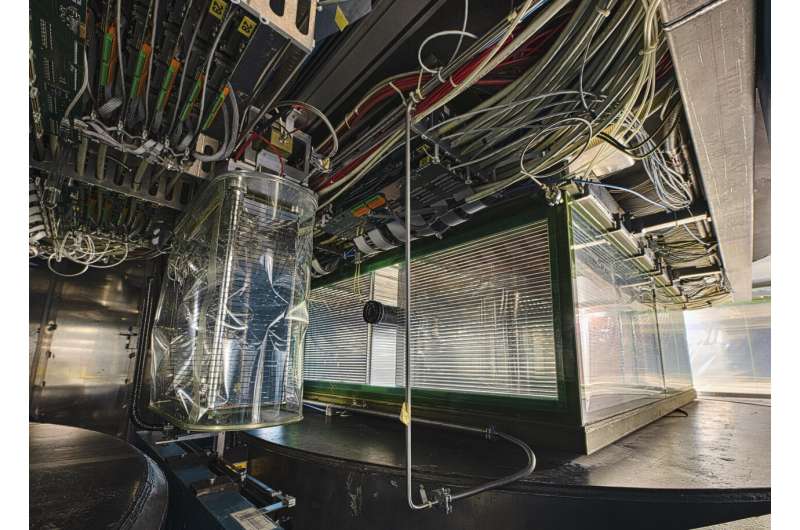NA61/SHINE gives neutrino experiments a helping hand

Neutrinos are the lightest of all the known particles that have mass. Yet their behavior as they travel could help answer one of the greatest puzzles in physics: why the present-day universe is made mostly of matter when the Big Bang should have produced equal amounts of matter and antimatter. In two recent papers, the NA61/SHINE collaboration reports particle measurements that are crucial for accelerator-based experiments studying such neutrino behavior.
Neutrinos come in three types, or "flavors," and neutrino experiments are measuring with ever increasing detail how they and their antimatter counterparts, antineutrinos, "oscillate" from one flavor to another while they travel. If it turns out that neutrinos and antineutrinos oscillate in a different way from one another, this may partially account for the present-day matter–antimatter imbalance.
Accelerator-based neutrino experiments look for neutrino oscillations by producing a beam of neutrinos of one flavor and measuring the beam after it has traveled a long distance. The neutrino beams are typically produced by firing a beam of high-energy protons into long, thin carbon or beryllium targets. These proton–target interactions produce hadrons, such as pions and kaons, which are focused using magnetic aluminum horns and directed into long tunnels, in which they transform into neutrinos and other particles.
To get a reliable measurement of the neutrino oscillations, the researchers working on these experiments need to estimate the number of neutrinos in the beam before oscillation and how this number varies with the energy of the particles. Estimating this "neutrino flux" is hard, because neutrinos interact very weakly with other particles and cannot be measured easily. To get around this, researchers estimate instead the number of hadrons. But measuring the number of hadrons is also challenging, because there are too many of them to measure precisely.
This is where experiments such as NA61/SHINE at CERN's Super Proton Synchrotron come in. NA61/SHINE can reproduce the proton–target interactions that generate the hadrons that transform into neutrinos. It can also reproduce subsequent interactions that protons and hadrons undergo in the targets and focusing horns. These subsequent interactions can produce additional neutrino-yielding hadrons.
The NA61/SHINE collaboration has previously measured hadrons generated in experiments at 31 GeV/c proton energy (where c is the speed of light) to help predict the neutrino flux in the Tokai-to-Kamioka (T2K) neutrino-oscillation experiment in Japan. The collaboration has also been gathering data at 60 and 120 GeV/c energies to benefit the MINERνA, NOνA and DUNE experiments at Fermilab in the US. The analysis of these datasets is progressing well and has most recently led to two papers: one describing measurements of interactions of protons with carbon, beryllium and aluminum, and another reporting measurements of interactions of pions with carbon and beryllium.
"These results are crucial for Fermilab's neutrino experiments," says Laura Fields, an NA61/SHINE collaboration member and co-spokesperson for MINERνA. "To predict the neutrino fluxes for these experiments, researchers need an extremely detailed simulation of the entire beamline and all of the interactions that happen within it. For that simulation we need to know the probability that each type of interaction will happen, the particles that will be produced, and their properties. So interaction measurements such as the latest ones will be vital to make these simulations much more accurate," she explains.
"Looking into the future, NA61/SHINE will focus on measurements for the next generation of neutrino-oscillation experiments, including DUNE and T2HK in Japan, to enable these experiments to produce high-precision results in neutrino physics," Fields concludes.
More information: A. Aduszkiewicz, et al. Measurements of production and inelastic cross sections for p+C, p+Be, and p+Al at 60 GeV/c and p+C and p+Be at 120 GeV/c. arXiv:1909.03351v1 [hep-ex]: arxiv.org/abs/1909.03351
A. Aduszkiewicz, et al. Measurements of hadron production in π+ + C and π+ + Be interactions at 60 GeV/c arXiv:1909.06294v1 [hep-ex]: arxiv.org/abs/1909.06294
Provided by CERN





















